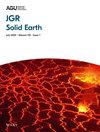阿拉伯东北板块晚白垩世蛇绿岩位位与新生代碰撞构造:来自新的宽带大地电磁资料的启示
IF 3.9
2区 地球科学
Q1 GEOCHEMISTRY & GEOPHYSICS
引用次数: 0
摘要
晚白垩世Semail蛇绿岩向被动阿拉伯边缘的逆冲,以及新生代新特提斯洋最终闭合的碰撞构造,是现今阿拉伯联合酋长国北部地壳结构的主要贡献者。我们从阿联酋北部的73个台站获得了第一个三维网格大地电磁观测,以成像与两次重要挤压事件相关的深部地壳电结构。宽带大地电磁数据反演揭示了高电阻率蛇绿岩块体、下伏的导电逆冲片(Haybi-Hawasina推覆体)、哈加尔山脉两侧的“楔形”导电前陆盆地以及与异域单元相邻的褶皱冲断带或元古代结晶基底相关的高电阻率构造的地下几何形状。沿东部海岸(从城市Khor Fakkan到Fujairah)的蛇绿岩厚度超过20公里,向东倾斜。在瓦迪哈姆断层上,阻性蛇绿岩与可能代表巴尼哈米德变质岩的阻性较低的物质相对。在Dibba带,特提斯沉积单元(Haybi-Hawasina杂岩)的近端-远端薄皮逆冲片具有低电阻率特征。与Dibba带缓慢东倾的几何形状相反,研究区南部的导电Haybi-Hawasina构造几乎垂直(> 20km)出现在密集的Khor Fakkan和Aswad蛇绿岩块体下方。这一结果表明,在南部密集蛇绿岩块体之下的逆冲片有广泛的变形。本文章由计算机程序翻译,如有差异,请以英文原文为准。
Late Cretaceous Ophiolite Emplacement and Cenozoic Collisional Tectonics in the Northeastern Arabian Plate: Insights From New Broadband Magnetotelluric Data
The Late Cretaceous obduction of the Semail Ophiolite onto the rifted passive Arabian margin and the Cenozoic collisional tectonics with the final closure of the Neo-Tethys Ocean, are major contributors to the present-day crustal architecture of the northern United Arab Emirates (UAE). We acquired the first 3D grid magnetotelluric observations from 73 stations in the northern UAE in order to image deep crustal electrical structures associated with the two significant compressional episodes. Inversion of the broadband magnetotelluric data reveals the subsurface geometry of the high-resistivity ophiolite blocks, the underlying conductive thrust sheet (Haybi-Hawasina nappe), a “wedge-shaped” conductive foreland basin flanking the Hajar mountain ranges, and at depth, a high-resistivity structure associated with a fold-thrust belt adjacent to the allochthonous units, or Proterozoic crystalline basement. The ophiolite along the eastern coast (from cities Khor Fakkan to Fujairah) is more than 20 km thick and dips eastward. Across the Wadi Ham fault, the resistive ophiolite lies against less resistive materials that may represent Bani Hamid metamorphic rocks. The thin-skinned thrust sheets of the proximal-distal Tethyan sedimentary units (Haybi-Hawasina complexes) exhibit low resistivity in the Dibba zone. In contrast to its gently east-dipping geometry in the Dibba zone, the conductive Haybi-Hawasina structure in the southern portion of the study area appears nearly vertically (>20 km) beneath the dense Khor Fakkan and Aswad ophiolite blocks. This result suggests extensive deformation of the thrust sheets beneath the southerly dense ophiolite blocks.
求助全文
通过发布文献求助,成功后即可免费获取论文全文。
去求助
来源期刊

Journal of Geophysical Research: Solid Earth
Earth and Planetary Sciences-Geophysics
CiteScore
7.50
自引率
15.40%
发文量
559
期刊介绍:
The Journal of Geophysical Research: Solid Earth serves as the premier publication for the breadth of solid Earth geophysics including (in alphabetical order): electromagnetic methods; exploration geophysics; geodesy and gravity; geodynamics, rheology, and plate kinematics; geomagnetism and paleomagnetism; hydrogeophysics; Instruments, techniques, and models; solid Earth interactions with the cryosphere, atmosphere, oceans, and climate; marine geology and geophysics; natural and anthropogenic hazards; near surface geophysics; petrology, geochemistry, and mineralogy; planet Earth physics and chemistry; rock mechanics and deformation; seismology; tectonophysics; and volcanology.
JGR: Solid Earth has long distinguished itself as the venue for publication of Research Articles backed solidly by data and as well as presenting theoretical and numerical developments with broad applications. Research Articles published in JGR: Solid Earth have had long-term impacts in their fields.
JGR: Solid Earth provides a venue for special issues and special themes based on conferences, workshops, and community initiatives. JGR: Solid Earth also publishes Commentaries on research and emerging trends in the field; these are commissioned by the editors, and suggestion are welcome.
 求助内容:
求助内容: 应助结果提醒方式:
应助结果提醒方式:


